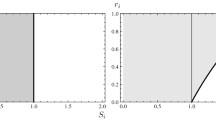Abstract
Conventional economic wisdom maintains that expansion of group size exacerbates group members' free riding tendencies. Nevertheless, experimental studies attempting to account for the effects of group size on free riding have failed to support a pure “numbers effect.” This study corroborates these experimental findings by examining contributions of church members from congregations of three prominent U.S. Protestant denominations. As a whole, these results show that, for congregations ranging from 7 members to 3,294 members, per member contributions do not decline with increased membership. The free-rider problem does not appear to be exacerbated by increases in group size.
Similar content being viewed by others
References
Brubaker, E.R. (1975). Free ride, free revelation, or golden rule.Journal of Law and Economics 18: 47–61.
Constitution. (1988). The Southern Baptist Convention.
Constitutions & Canons for the Government of the Protestant Episcopal Church in the United States. (1988). The Episcopal Church.
The Constitution of the Presbyterian Church (U.S.A.) Part II, Book of Order. (1988). Louisville, KY: The Office of the General Assembly.
Cornes, R. and Sandler, T. (1984). Easy riders, joint production, and public goods.Economic Journal 94: 580–598.
Hansmann, H. (1981). Nonprofit enterprises in the performing arts.Bell Journal of Economics 12: 341–361.
Iannaccone, L.R. (1988). A formal model of church and sect.American Journal of Sociology 49: S241-S268.
Iannaccone, L.R. (1992). Sacrifice and stigma: Reducing free-riding in cults, communes, and other collectives.Journal of Political Economy 100: 271–291.
Isaac, R.M., McCue, K.F. and Plott, C.R. (1985). Public goods provision in an experimental environment.Journal of Public Economics 26: 51–74.
Isaac, R.M. and Walker, J.M. (1988). Group size effects in public goods provision: The voluntary contributions mechanism.Quarterly Journal of Economics 103: 179–199.
Isaac, R.M., Walker, J.M. and Thomas, S.H. (1984). Divergent evidence on free riding: An experimental examination of possible explanations.Public Choice 43: 113–149.
Johnson, D.W. (1973). The North American interchurch study pastor's report on the congregation. In C.H. Jacquet, Jr. (Ed.),Yearbook of American and Canadian churches 1973, 253–257. Nashville, TN: Abingdon Press.
Marwell, G. and Ames, R.E. (1981). Economists free ride, does anyone else?: Experiments of the provision of public goods.Journal of Public Economics 15: 295–310.
McKinney, W. and Roof, W.C. (1982). A social profile of American religious groups. In C.H. Jacquet, Jr. (Ed.),Yearbook of American and Canadian churches 1982, 267–273. Nashville, TN: Abingdon Press.
Olson, M. (1965).The logic of collective action. Cambridge, MA: Harvard University Press.
Samuelson, P.A. (1954). The pure theory of public expenditure.Review of Economcis and Statistics 36: 387–389.
Schneider, F. and Pommerehne, W.W. (1981). Free riding and collective action: An experiment in public microeconomics.Quarterly Journal of Economics 96: 689–704.
Stigler, G.J. (1974). Free riders and collective action: An appendix to theories of economic regulation.Bell Journal of Economics and Management Science 5: 359–365.
Sugden, R. (1984). Reciprocity: The supply of public goods through voluntary contributions.Economic Journal 94: 772–787.
Author information
Authors and Affiliations
Additional information
I thank W. Mark Crain, William R. Dougan, David Laband, David Levy, Fred McChesney, Robert E. McCormick, Roger Meiners, Jennifer Roback, Robert D. Tollision, John Warner, Bruce Yandle, and an anonymous referee for helpful comments. I also thank Dr. Richard Andrews, Rev. Thomas C. Davis and Rev. Bill Ellison for their contributions to this paper. Finally, I acknowledge an intellectual debt to Robert J. Staaf. I alone am responsible for any remaining errors.
Rights and permissions
About this article
Cite this article
Lipford, J.W. Group size and the free-rider hypothesis: An examination of new evidence from churches. Public Choice 83, 291–303 (1995). https://doi.org/10.1007/BF01047748
Accepted:
Issue Date:
DOI: https://doi.org/10.1007/BF01047748



